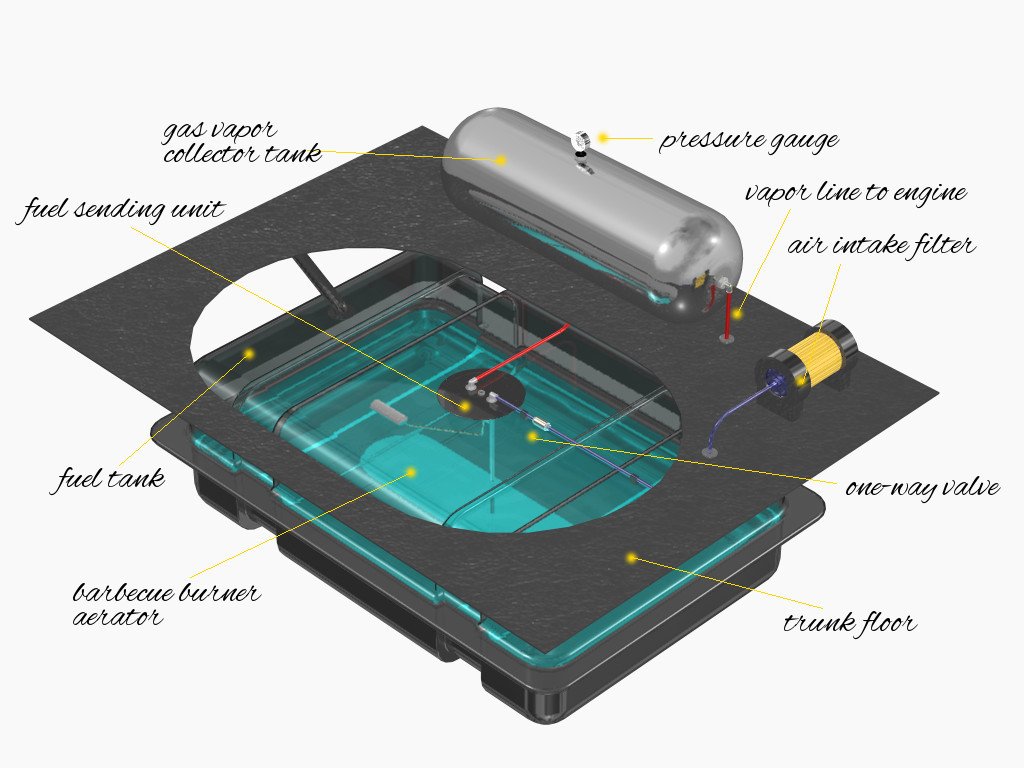
Automakers can exponentially increase their vehicle’s fuel mileage and reduce CO2 emmissions by utilizing a fuel vapor system designed by PRESS Core editor that converts liquid gasoline/fuel into a gas vapor to fuel vehicles’ engine. According to the US government gas vapor and not liquid fuel is what runs all internal combustion engines.
All internal combustion engines actually run on vapor, not liquid. The liquid fuels used by gasoline engines are vaporized before they enter the combustion chamber above the pistons.
According to FEMA automakers can exponentially increase their vehicle’s fuel mileage by using only the gas vapor. All vehicles on the road today would run more efficiently if only fuel vapor was used. If all vehicles were fueled only by fuel vapor carbon emissions would drastically diminish.
As FEMA has stated all cars and trucks “actually run on vapor not liquid” fuel. The auto makers know this, yet still do not assemble any cars or trucks with a fuel vapor fuel system. Auto makers make no attempts to vaporize the liquid gasoline. They replaced carburetors with fuel injectors but a vehicle’s fuel injectors do not inject fuel vapor into the combustion chamber of your vehicle’s engine. Fuel injectors inject fuel droplets, which is still a liquid fuel.
Fuel injectors didn’t increase fuel mileage, they regulate and control the precise amount of fuel that is consumed by your vehicle’s engine via fuel injectors that are precisely controlled by your vehicle’s electronic control module (ECM). The ECM was introduced to prevent your vehicle from achieving higher fuel efficiency by automatically regulating the air fuel mixture so that it only runs using the oil and gas companies’ high fuel consumption standard of 14.6:1 air:fuel mixture.
Simply by increasing the air fuel mixtures to 17:1 or higher will automatically achieve much higher fuel mileage, however, the ECM makes sure it doesn’t. The ECM makes sure oil and gas companies make a profit with high liquid fuel demand and consumption.
By converting liquid fuel into a fuel vapor at the source – the gas tank – much higher fuel mileage is achievable. Higher fuel mileage means lower fuel demand and a substantial fuel cost saving. Instead of pumping liquid fuel from the fuel tank and through the fuel line, fuel vapor is generated and pumped through your vehicle’s fuel system.
The same principle has been used for decades in propane fueled vehicles worldwide. In propane fueled vehicles (taxis and police patrol cars) the liquid propane stored in a propane tank is converted into a gases state in the engine compartment.
Every car or truck can be converted into a high mileage fuel vapor vehicle using the vehicle’s existing fuel tank and fuel sending unit. There is no need to manufacture any new parts as this fuel vapor system uses existing mass produced, store bought parts. You will need 3 main parts:
1) a propane tank – will function as a fuel vapor collector tank. The collector tank collects and stores the generated fuel vapor.
2) an aerator affixed to the bottom of the liquid fuel tank so that filtered air can be pumped into the liquid fuel. Pumping filtered air into the liquid fuel causes the air to become saturated with the fuel as it rises out of the liquid fuel and into a fuel line attached fuel vapor collector tank.
3) a large air filter – filters the air before it enters the liquid fuel tank. Filtering the air before it is pumped into the aerator prevents dirt from clogging the aerator. Mass produced truck air filter or custom car air filter can be used.
To connect the above components you will also need a number of fuel lines, fuel line fittings for the air filter and fuel vapor collector tank and a pressure gauge. The fittings you buy must be for fuel lines. Custom car / automotive parts stores will carry the right fittings, fuel lines and air filters for the conversion. Heavy truck parts stores will more than likely have the air brake tank you will need.
Liquid fuel aeration converts liquid gasoline into a highly combustible gas vapor, inside the liquid fuel tank.
Fuel tank aeration (draw in filtered air into the liquid fuel) effectively converts the liquid fuel in the fuel tank into a fuel vapor without adding heat or making any expensive modification.
Fuel vapor not only increases fuel efficiency it also reduces carbon emissions and fuel cost. You can drive a lot farther when you fuel your vehicle with fuel vapor. How much farther? The saturated vapor volume of an average gallon of liquid gasoline when fully evaporated is 160 gallons of vapor at 60° F and sea level. That means, if you were able to completely vaporize 1 gallon of liquid gasoline you would have 160 gallons of fuel vapor.
Fuel vapor burns much cleaner than liquid gasoline and has a higher octane rating. A lean running engine (ie, an engine using more air than fuel) has a cooler combustion process than the typical ECM engine with a preset (never deviating) chemically correct mixture of 14.6 air : 1 fuel. Running cooler is also better for the engines. Cooler running engines means a reduction in heat damage and failure.
Related posts:
Views: 0
 RSS Feed
RSS Feed















 August 19th, 2021
August 19th, 2021  Awake Goy
Awake Goy  Posted in
Posted in  Tags:
Tags: 
















